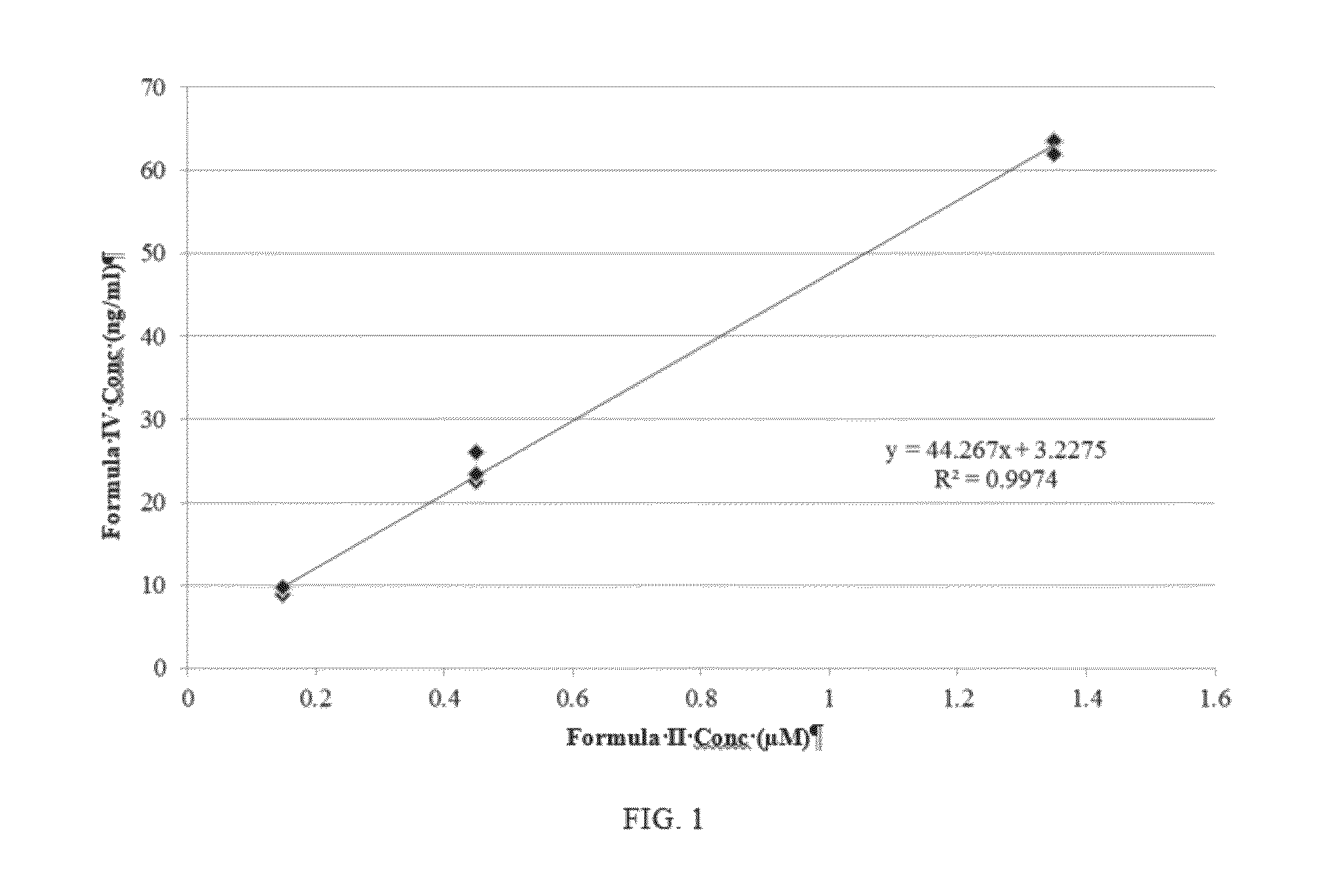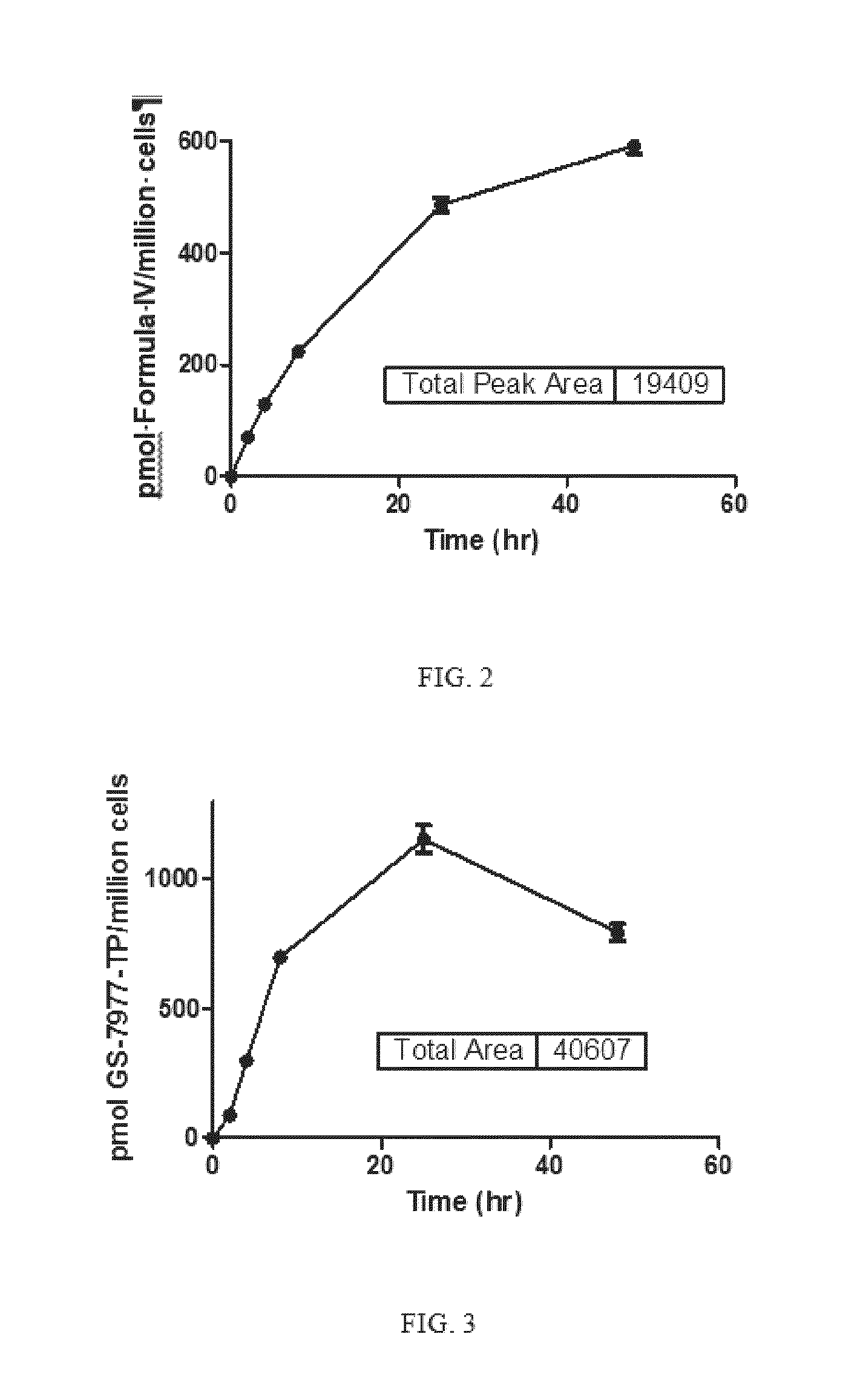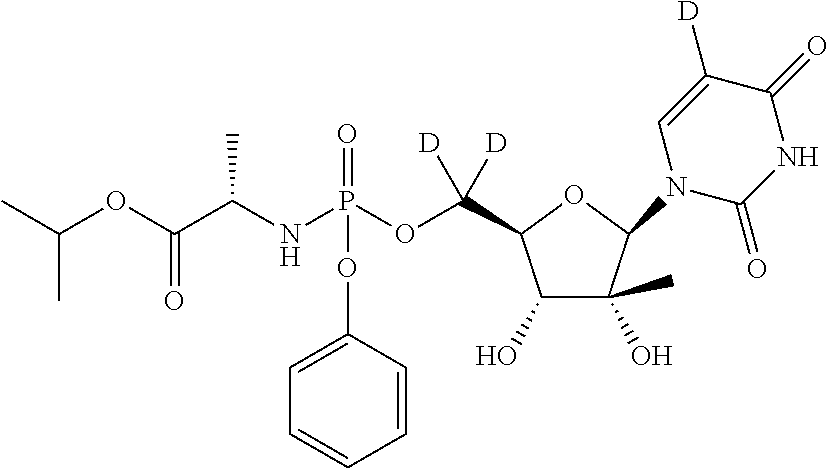Highly active nucleoside derivative for the treatment of HCV
a nucleoside derivative and high-active technology, applied in the direction of biocide, group 5/15 element organic compound, drug composition, etc., can solve the problems of patient vomiting/nausea serious adverse event, compromise or lower efficacy, etc., to increase the critical nucleoside triphosphate level, inhibit viral replication, and drive the effect of level and intrinsic potency
- Summary
- Abstract
- Description
- Claims
- Application Information
AI Technical Summary
Benefits of technology
Problems solved by technology
Method used
Image
Examples
example 1
(S)-isopropyl 2-(((S)-(perfluorophenoxy)(phenoxy)phosphoryl)amino)propanoate (Compound 1)
[0183]
[0184]L-Alanine isopropyl ester HCl salt (160 g) is charged in a 5 L four-necked flask equipped with mechanical stirrer, thermometer and dropping funnel To the flask, dichloromethane (1 L) is added and the suspension is cooled to −70° C., followed by addition of triethylamine (200 g, 276 mL) over 45 min. To the mixture is added a solution of phenyl dichlorophosphate (200 g) in dichloromethane (1 L) over 2.5 h. The reaction mixture is stirred at this temperature for an additional 90 min and then allowed to warm up to 0° C. over a period of 2 h and stirred for 2 h at 0° C. To the mixture a solution of 2,3,4,5,6-pentafluorophenol (174.4 g) in 400 mL dichloromethane and a solution of triethylamine (105.4 g) in 200 mL dichloromethane are added dropwise simultaneously over a period of 1.2 h. The mixture is warmed to rt. and stirred overnight. The solid, triethylamine HCl salt, is filtered off an...
example 2
Preparation of (S)-isopropyl 2-(((R)-(((2S,3R,4R,5R)-5-(2,4-dioxo-3,4-dihydropyrimidin-1(2H)-yl)-3,4-dihydroxy-4-methyltetrahydrofuran-2-yl)dideuteromethoxy)(phenoxy)phosphoryl)amino)propanoate (Compound 7)
[0186]
[0187]2,2-Dimethylpropane (140 mL) is added to 2′-C-methyluridine 2 (100 g) in acetone (700 mL). The resulting mixture is cooled in an ice bath for 30 min, then p-toluenesulfonic acid (11 g) is added and the reaction mixture is stirred at rt. for 24 h. After completion of the reaction (monitored by HPLC), the reaction mixture is cooled in an ice bath for 30 min and neutralized using cold potassium carbonate (12 g in 13 mL water, pH 7-8). The solvent is removed under reduced pressure until dryness. THF (˜500 mL) is added to the residue and the solids are removed by filtration. The filtrate is co-evaporated with silica gel and purified by chromatography over silica gel (5-15% MeOH in CHCl3) to give compound 3. 1H NMR (400 MHz, DMSO-d6, 300 K): δ 1.22 (s, 3H), 1.34 (s, 3H), 1.4...
example 3
Preparation of (S)-isopropyl 2-(((S)-(((2R,3R,4R,5R)-5-(5-deutero-2,4-dioxo-3,4-dihydropyrimidin-1(2H)-yl)-3,4-dihydroxy-4-methyltetrahydrofuran-2-yl)dideuteromethoxy)(phenoxy)phosphoryl)amino)propanoate (Formula IIa, Compound 10)
[0192]
[0193]NaBD4 (7.96 g) is added in portions to a cooled (5° C.) 70:30 v / v mixture of EtOD / D2O (350 mL, 99% D) in a 1 L flask, followed by the addition of acetonide ester 4 (35 g) in portions (slowly bubbles). The resulting reaction mixture is stirred at rt. for 3 h, and then heated at 80° C. for 1 d (1H NMR spectroscopic analysis indicates >85% deuterium incorporation at the 5-uracil position). The reaction mixture is filtered to remove solids and concentrated under reduced pressure to remove EtOD. Additional D2O is added and the resulting mixture reheated at 95° C. to increase the deuterium incorporation at the 5 position to >98% (D-incorporation monitored by 1H NMR spectroscopy). After completion of the reaction, half the solvent is removed under redu...
PUM
| Property | Measurement | Unit |
|---|---|---|
| wt. % | aaaaa | aaaaa |
| wt. % | aaaaa | aaaaa |
| wt. % | aaaaa | aaaaa |
Abstract
Description
Claims
Application Information
 Login to View More
Login to View More - R&D
- Intellectual Property
- Life Sciences
- Materials
- Tech Scout
- Unparalleled Data Quality
- Higher Quality Content
- 60% Fewer Hallucinations
Browse by: Latest US Patents, China's latest patents, Technical Efficacy Thesaurus, Application Domain, Technology Topic, Popular Technical Reports.
© 2025 PatSnap. All rights reserved.Legal|Privacy policy|Modern Slavery Act Transparency Statement|Sitemap|About US| Contact US: help@patsnap.com



